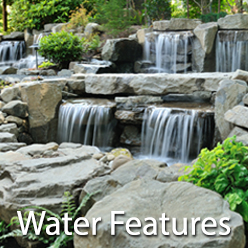Pump Systems
Sprinkler Pump Systems
 With all the lake front properties we have in the Puget Sound many systems exist that pump water from lakes or ponds. Pumps are also used to pressure sprinkler systems supplied by private wells and in some cases they’re used to boost pressure in city water systems with low pressure. Pump systems definitely add another layer of complexity to diagnosing and repairing sprinkler issues. Unlike city supplied water systems – pump systems almost never have water meters which are a needed diagnostic tool for tracking down leaks. Water meters enable us to confirm that a system is holding tight without leaks, without a water meter confirming this is much more difficult. What we’ve learned about sprinkler pump systems is they’re like snowflakes – no two systems are alike. This is why we document all systems that we work on in our database so on subsequent visits we don’t waste time re-learning your system. At Aquasense our senior lead techs are qualified to handle your sprinkler pump needs.
With all the lake front properties we have in the Puget Sound many systems exist that pump water from lakes or ponds. Pumps are also used to pressure sprinkler systems supplied by private wells and in some cases they’re used to boost pressure in city water systems with low pressure. Pump systems definitely add another layer of complexity to diagnosing and repairing sprinkler issues. Unlike city supplied water systems – pump systems almost never have water meters which are a needed diagnostic tool for tracking down leaks. Water meters enable us to confirm that a system is holding tight without leaks, without a water meter confirming this is much more difficult. What we’ve learned about sprinkler pump systems is they’re like snowflakes – no two systems are alike. This is why we document all systems that we work on in our database so on subsequent visits we don’t waste time re-learning your system. At Aquasense our senior lead techs are qualified to handle your sprinkler pump needs.
 Winterization is especially important with pump systems which are much more vulnerable to freezing then buried sprinkler systems. We recommend winterizing pump systems by mid-October to avoid losing a pump to an early freeze. We make it a point to contact our customers with pump systems early and give them priority when it comes to winterization.
Filtration Systems: Debris that is pulled from local lakes can end up clogging sprinkler nozzles and drip systems. Aquasense installs a filtration system that filters the water then automatically cleans the filter after every sprinkling cycle. Depending on severity of the lake debris, the filter benefits from a hand scrubbing at spring activation and another at mid-season.
Importance of Pressure Regulation: Pressure regulation in pump systems is important to keep pumps from overheating. Unlike city water supplied sprinkler systems if a valve fails to open in a sprinkler pump system the pump will continue to run without flow. If this occurs and there is no pressure regulation the water in the pump will over heat and in many cases it melts plastic fittings installed on the pump. As the fittings melt the prime is lost and then the pump runs dry. Best case scenario is the pump needs to be re-plumbed and then re-primed. Worst case scenario is the pump is toast.
Winterization is especially important with pump systems which are much more vulnerable to freezing then buried sprinkler systems. We recommend winterizing pump systems by mid-October to avoid losing a pump to an early freeze. We make it a point to contact our customers with pump systems early and give them priority when it comes to winterization.
Filtration Systems: Debris that is pulled from local lakes can end up clogging sprinkler nozzles and drip systems. Aquasense installs a filtration system that filters the water then automatically cleans the filter after every sprinkling cycle. Depending on severity of the lake debris, the filter benefits from a hand scrubbing at spring activation and another at mid-season.
Importance of Pressure Regulation: Pressure regulation in pump systems is important to keep pumps from overheating. Unlike city water supplied sprinkler systems if a valve fails to open in a sprinkler pump system the pump will continue to run without flow. If this occurs and there is no pressure regulation the water in the pump will over heat and in many cases it melts plastic fittings installed on the pump. As the fittings melt the prime is lost and then the pump runs dry. Best case scenario is the pump needs to be re-plumbed and then re-primed. Worst case scenario is the pump is toast.




